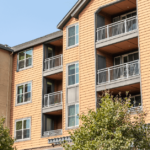LIHTC rehabilitation plays a very important role in preserving and revitalizing affordable housing communities. By modernizing existing properties, this process enhances living conditions, ensures long-term sustainability, and meets regulatory requirements. Developers must navigate complex tax credit applications, implement effective affordable housing redevelopment strategies, and work closely with contractors who bring valuable expertise to each project.
Successful LIHTC rehabilitation requires a well-structured approach, including securing funding, following compliance guidelines, and applying developer best practices to achieve high-quality outcomes. This blog by Mid Town Builders will explore key strategies, from project planning to contractor insights, ensuring a seamless redevelopment process.
What is LIHTC Rehabilitation?
The Low-Income Housing Tax Credit (LIHTC) program provides funding for developers to upgrade aging affordable housing units. LIHTC rehabilitation focuses on improving properties while maintaining affordability for residents.
Understanding LIHTC Rehabilitation Projects:
- Upgrading existing housing units to meet modern safety and efficiency standards.
- Ensuring long-term affordability by following LIHTC program guidelines.
- Integrating energy-efficient solutions to reduce utility costs.
- Navigating funding processes through tax credit applications and financial incentives.
By aligning these elements, developers can execute affordable housing redevelopment projects that benefit both residents and investors.
Affordable Housing Redevelopment Strategies
A structured approach is key to executing successful affordable housing redevelopment. This involves careful planning, financial management, and collaboration with experienced professionals.
Effective Strategies for Housing Redevelopment:
- Assessing property conditions to identify necessary upgrades.
- Securing funding through federal and state programs.
- Applying for tax credits to maximize project feasibility.
- Partnering with contractors who specialize in LIHTC rehabilitation.
Using these strategies helps streamline the redevelopment process and ensures project success.
Navigating Tax Credit Applications
Applying for LIHTC funding requires careful preparation and adherence to strict guidelines. Properly managed tax credit applications increase approval chances and provide essential funding for LIHTC rehabilitation projects.
Key Steps in Tax Credit Applications:
- Review eligibility requirements to determine project qualifications.
- Prepare detailed documentation outlining the scope, cost, and impact of the project.
- Work with housing agencies to ensure compliance and expedite processing.
- Monitor regulatory changes to avoid delays in application approvals.
Well-prepared tax credit applications provide financial stability for affordable housing redevelopment, ensuring long-term project success.
Developer and Contractor Best Practices
Collaborating with experienced professionals is essential for efficient LIHTC rehabilitation. Adopting developer best practices and leveraging contractor insights enhances project execution.
Best Practices for Developers in LIHTC Projects:
- Establish clear objectives aligned with project goals.
- Create accurate cost estimates to prevent budget overruns.
- Ensure compliance with LIHTC regulations to maintain funding eligibility.
- Develop strong partnerships with construction teams and financial institutions.
Insights from Experienced Contractors:
- Use high-quality materials that meet LIHTC standards.
- Follow energy-efficient building practices to enhance sustainability.
- Ensure timely project completion by avoiding common construction delays.
- Maintain compliance with federal and state guidelines.
By following developer best practices and utilizing contractor insights, projects achieve better efficiency and long-term value.
Case Study: Revitalizing Willow Creek Apartments
Willow Creek Apartments, a 120-unit affordable housing community, underwent a full LIHTC rehabilitation to modernize aging infrastructure while maintaining affordability. The project secured funding through tax credit applications, upgraded HVAC and electrical systems, and improved resident amenities. By leveraging developer best practices and experienced contractor insights, the redevelopment was completed on time and within budget, ensuring a lasting impact for the community.
Avoiding Common Pitfalls in LIHTC Redevelopment
Even well-planned affordable housing redevelopment projects can encounter challenges. Anticipating and addressing potential issues ensures smoother execution.
Common Challenges and Solutions:
- Incomplete tax credit applications – Work with specialists to ensure accuracy.
- Budget overruns – Implement strict cost tracking and financial planning.
- Construction delays – Maintain proactive communication with contractors.
- Regulatory compliance issues – Stay updated on LIHTC guidelines.
By mitigating these risks, developers improve the success rate of LIHTC rehabilitation projects.
Achieving Success in LIHTC Rehabilitation
Success in LIHTC rehabilitation depends on strategic planning, securing tax credit applications, implementing affordable housing redevelopment strategies, and following developer best practices with expert contractor insights. Ensuring compliance, maintaining budgets, and working with skilled teams streamline the process for long-term project success. Contact us to discuss how to optimize your next redevelopment project.










